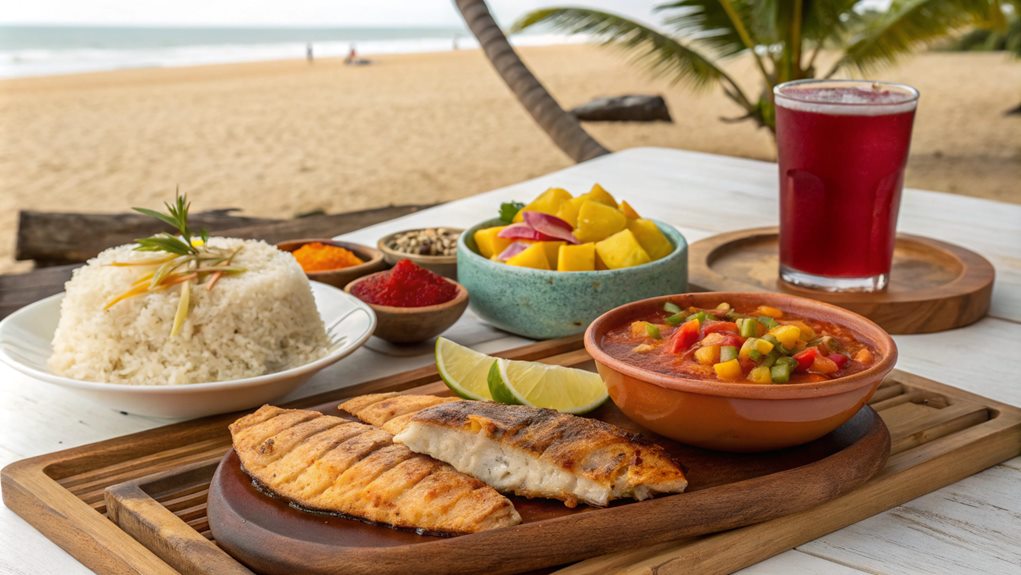As a food lover in Cape Verde, you’re in for a flavor explosion! Each island offers its own culinary specialties – seafood in Sal, traditional dishes in Santiago. Savor the national dish, Cachupa, a hearty corn and bean stew, or indulge in tuna tartare showcasing the ocean’s bounty. Don’t miss Buzio, a succulent shellfish stew, and Bol de Cus-Cus, a sweet corn cake. Sip on local sugarcane spirits and tropical fruit juices. Dine with the locals, where communal meals emphasize warm hospitality. With so much to tempt your taste buds, you’ll wish you had more than one stomach to explore Cape Verde’s mouthwatering cuisine.
Key Takeaways
- Savor the fusion of African, Portuguese, and Brazilian influences in Cape Verdean cuisine, showcased in signature dishes like Cachupa, Buzio, and Bol de Cus-Cus.
- Delight in the bounty of the sea with fresh seafood specialties, including grilled lobster, tuna tartare, and the comforting Caldo de Peixe fish soup.
- Explore the diverse meat and poultry dishes, such as the hearty Canjo chicken soup and spicy Piri Piri-infused delicacies.
- Indulge in the vibrant tropical fruits and vegetables that are integral to the local cuisine, from mango and papaya to yam and sweet potato.
- Experience the lively culinary culture, with communal dining, local markets, and festivals highlighting the islands’ rich gastronomic heritage and hospitality.
Dining Experiences Across Cape Verde
Dining experiences across Cape Verde offer an enchanting blend of flavors and cultural immersion. Each island has its own culinary specialties, from the seafood-centric menus in Sal to the traditional Cape Verdean dishes celebrated at spots like Restaurant Creole on Santiago.
Many popular eateries feature live music, creating a lively atmosphere that showcases the islands’ vibrant culture. Reservations are recommended for sought-after restaurants, where you can savor local favorites like the hearty stew Cachupa or the fresh Tuna Tartare, all while enjoying the fusion of African, Portuguese, and Brazilian influences that shape Cape Verdean cuisine.
Whether you’re seeking a casual beachside meal or a refined dining experience, the islands’ culinary diversity promises a delightful adventure for food lovers.
Signature Dishes and Culinary Heritage
What defines the culinary heritage of Cape Verde? It’s a delicious fusion of African, Portuguese, and Brazilian influences.
You’ll find hearty stews like the national dish Cachupa, showcasing local corn, beans, and meats or fish.
Then there’s Buzio, a slow-cooked shellfish stew that highlights the island’s seafood bounty.
For dessert, don’t miss Bol de Cus-Cus, a sweet corn cake served warm with butter and cheese.
From grilled lobster to tuna tartar, the ocean is central to Cape Verdean cuisine.
Savor these signature dishes and discover the rich culinary tapestry that defines this island nation.
- Cachupa: A hearty national stew
- Buzio: A flavorful shellfish stew
- Bol de Cus-Cus: A traditional sweet corn cake
Seafood Specialties and Fresh Catches
Cape Verde’s coastal towns serve up a bounty of fresh seafood delights that highlight the islands’ rich marine heritage.
You’ll find octopus, bream, and grouper swimming alongside the highly sought-after local tuna, renowned for its superior flavor.
Traditional dishes like Lagosta Suada (steamed lobster) and Buzio (slow-cooked shellfish stew) showcase these local seafood specialties.
Appetizers like Carpachio (thinly sliced raw tuna) and Tuna Tartare offer a tantalizing taste of the sea.
And the hearty Caldo de Peixe, a flavorful fish soup, is a comforting way to savor the fresh catches.
Whether you’re feasting at a seaside extravaganza or exploring local restaurants, Cape Verde’s seafood is a culinary treasure waiting to be discovered.
Meat and Poultry Delights
How can one overlook the delectable meat and poultry dishes that grace Cape Verdean tables? From the ever-popular chicken, often prepared in spicy and curried styles, to the tender and succulent goat meat that’s a local specialty, the islands offer a mouthwatering array of options.
- Canjo, a hearty chicken soup with rice, onions, and carrots, showcases the robust flavors that define Cape Verdean cuisine.
- Piri Piri sauce, an eye-wateringly hot chili sauce, adds a fiery kick to many meat dishes, perfectly complementing the islands’ love for bold flavors.
- While steak may be limited and pricey, the abundance of affordable and flavorful chicken and goat make them the preferred choices for many diners.
Fruits, Vegetables, and Local Produce
The islands of Cape Verde boast an abundance of fresh, locally grown produce that plays an essential role in the region’s vibrant culinary landscape. Mango, papaya, and kiwi thrive on the fertile island of Santo Antão, while staples like yam, sweet potato, courgette, and manioc are common sights in local dishes. Bananas, utilized at various ripening stages, showcase their versatility – firm ones can even be cooked like potatoes! The local yogurt, especially when paired with tropical fruits and molasses, is renowned for its quality and flavor. Hearty portions and communal dining are the norm, so be ready to share and savor the fresh bounty of Cape Verde’s bountiful gardens.
| Fruits | Vegetables | Dairy |
|---|---|---|
| Mango | Yam | Yogurt |
| Papaya | Sweet Potato | Molasses |
| Kiwi | Courgette | |
| Banana | Manioc |
Beverages, Desserts, and Economic Impact
While the produce of Cape Verde’s fertile lands takes center stage in the local cuisine, the islands’ vibrant culinary landscape extends beyond the bountiful gardens.
You can’t leave without sampling the potent Grogue spirit, a sugarcane-based staple, or indulging in the invigorating local beers like Super Bock and Strela at just €1.50 a bottle.
And for something sweet, don’t miss the delightful tropical desserts like Doce de Papaya and Bol de Cus-Cus.
Beyond the plate, the fishing industry is the backbone of Cape Verde’s economy, fueling a growing culinary tourism sector and ensuring a steady supply of fresh, sustainably sourced seafood.
Here are 3 key things to savor in Cape Verde:
- Grogue, the island’s signature spirit
- Affordable, locally brewed beers
- Tropical fruit-based desserts
Exploring the Island Cuisine
Frequently, you’ll find Cape Verdean cuisine to be a vibrant fusion of African, Portuguese, and Brazilian flavors, with fresh seafood taking center stage in dishes such as grilled fish and lobster.
Each island offers unique culinary offerings, with Sal known for its beachside eateries serving specialties like Lagosta Grelhada (grilled lobster) and Cachupa, the national dish.
In Espargos, the culinary hub of Sal, bustling local markets provide a colorful array of fresh ingredients for traditional dishes.
Local specialties like Buzio, a slow-cooked shellfish stew, and Tuna Tartare showcase the islands’ abundant seafood and culinary creativity.
Cape Verdean meals often emphasize communal dining with hearty portions, reflecting the rich cultural heritage.
Culinary Diversity and Cultural Experiences
Immersing yourself in Cape Verde’s culinary diversity grants a deeper appreciation for the islands’ vibrant cultural heritage.
From the national dish, Cachupa, a slow-cooked stew that reflects the local agricultural and fishing traditions, to the colorful markets showcasing fresh produce, Cape Verdean cuisine offers a feast for the senses.
The culinary experiences are further enhanced by cultural traditions, with dishes often served communally and festivals highlighting local foods.
Consider these tempting options:
- Savor authentic dishes while tapping your feet to the rhythms of traditional music and dance.
- Explore the lively markets, discovering unique ingredients essential for Cape Verdean cooking.
- Partake in communal meals, fostering a deeper connection to the islands’ warm hospitality.
Frequently Asked Questions
What Do They Drink in Cape Verde?
In Cape Verde, you’ll enjoy a vibrant local beverage scene – from traditional firewater grogue to revitalizing fruit juices, unique cocktails like caipirinha, and a growing wine culture featuring Fogo wine. Don’t miss the coconut water and coffee too!
What Do They Eat for Breakfast in Cape Verde?
You’ll find Cape Verde’s breakfast reflects the islands’ diversity – from hearty cachupa variations to traditional pastries, morning coffee, and an abundance of local fruits. Breakfast here celebrates regional influences and cultural significance.
How Much Is a Pint of Beer in Cape Verde?
A pint of local Cape Verdean beer will typically cost you around €4, though you might find it for as low as €1.50 at local markets. Popular brands like Strela and Super Bock are widely available and enjoyed as part of the island’s drinking customs.
Is It Expensive to Eat Out in Sal Cape Verde?
Eating out in Sal, Cape Verde isn’t too expensive. You can find tasty local cuisine at mid-range restaurants, affordable street food, and budget-friendly dining options. Explore the local markets and savor traditional dishes without breaking the bank.


Comment (0)